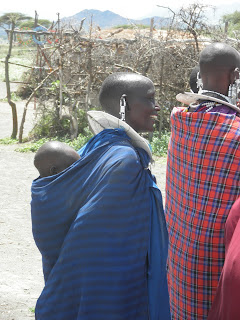What are the boundaries between legitimate inquiry-based tourism and exploitative voyeurism? To date this has not been an issue I have had to deal with, but a 'scheduled visit' to a Maasai community on our recent trip brought these thoughts to the surface. Today Maasai live from the outskirts of Arusha, through the agricultural lands approaching Manyara and then Ngorongoro, and especially the Ngorongoro Conservation Area which extends westward from the crater to the boundary with the Serengeti National Park.
Having made the visit to a Maasai village and seen first hand how and where they live one is struck by the complexity yet sophistication of their culture. At the same time they conserve some manners of living that are antithetical to emergent values in our own society, such as patriarchy and a high value on animal ownership (i.e., numbers) rather than, say productivity, or concerns for grazing pressure. I learnt that sheep and goats are more lucrative than cattle, though culturally the latter are most important. In the village we visited, five out of about 100 spoke English and only a similar number had received more then basic primary school education. On the other hand it is hard to imagine how, having moved from one world to an another, the two cutural trajectories (the Maasai and the 'global west') could be embodied in one individual, yet alone group.
These concerns are the subject of serious scholarship and the Maasai themselves. As noted in Wikipedia the "Maasai are pastoralist and have resisted the urging of the Tanzanian and
Kenyan governments to adopt a more sedentary lifestyle. They have
demanded grazing rights to many of the national parks in both countries." There is also a good summary of the range of outside influences on Maasai life and culture:
"Maintaining a traditional pastoral lifestyle has become increasingly difficult due to outside influences of the modern world. Garrett Hardin's article, outlining the "tragedy of the commons", as well as Melville Herskovits'
"cattle complex" helped to influence ecologists and policy makers about
the harm Maasai pastoralists were causing to savannah rangelands. This
concept was later proven false by anthropologists but is still deeply ingrained in the minds of ecologists and Tanzanian officials.[40]
This influenced British colonial policy makers in 1951 to remove all
Maasai from the Serengeti National Park and relegate them to areas in
and around the Ngorongoro Conservation Area
(NCA). The plan for the NCA was to put Maasai interests above all else,
but this promise was never met. Due to an increase in Maasai
population, loss of cattle populations to disease, and lack of available
rangelands due to new park boundaries, the Maasai were forced to
develop new ways of sustaining themselves. Many Maasai began to
cultivate maize and other crops to get by, a practice that was
culturally viewed negatively.[40]
Cultivation was first introduced to the Maasai by displaced WaArusha
and WaMeru women who were married to Maasai men; subsequent generations
practiced a mixed livelihood. To further complicate their situation, in
1975 the Ngorongoro Conservation Area banned cultivation practices. In
order to survive they are forced to participate in Tanzania’s monetary
economy. They have to sell their animals and traditional medicines in
order to buy food. The ban on cultivation was lifted in 1992 and
cultivation has again become an important part of Maasai livelihood.
Park boundaries and land privatisation has continued to limit grazing
area for the Maasai and have forced them to change considerably".[41]
The situation of the Maasai is usefully understood as a 'wicked problem'; there are clearly no 'right answers but merely responses with fewer unintended systemic consequences. The book Staying Maasai? Livelihoods, Conservation and Development in East African Rangelands explores many of the systemic issues:
"People, livestock and wildlife have lived together on the savannas of
East Africa for millennia. Their coexistence has declined as
conservation policies increasingly exclude people and livestock from
national wildlife parks, and fast-growing human populations and
development push wildlife and pastoralists onto ever more marginal
lands. The result has been less wildlife, and more pastoral people
struggling to diversify their livelihoods as access to pasture and water
becomes harder to find.
This book examines those livelihood and land use strategies in
detail. In an integrated research effort that involved researchers,
local communities and policy analysts, surveys were carried out across a
wide range of Maasai communities providing contrasting land tenure and
national policies and varying degrees of intensification of agriculture,
tourism and other activities. The aim was to create a better
understanding of current livelihood patterns and the decisions facing
Maasai at the start of the 21st Century in the context of
ongoing environmental, political, and societal change.......
While livestock remains the critical anchor for most Maasai
households, many are obtaining income from a variety of alternative
sources. Unfortunately, income from wildlife/tourism, an option seen as
most desirable by many because of its potential to provide economically
and environmentally ‘win-win’ situations, still benefits relatively few
Maasai. Similarly, although governments favor agricultural
intensification, significant crop income or enhanced food security from
subsistence cropping elude most."









No comments:
Post a Comment